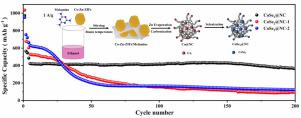Solid State Ionics ( IF 3.2 ) Pub Date : 2021-08-26 , DOI: 10.1016/j.ssi.2021.115747 Yongkang Wang , Yinglong Wu , LinZhi Liu , Tianci Yan , Guang Zeng , Lingjun Li , Junfei Duan , Zhaoyong Chen

|
Transition metal selenides are considered to be a potential anode material for lithium-ion batteries (LIBs) owing to their excellent electronic conductivity and high theoretical capacity. However, the application of transition metal selenides electrodes is still limited by their large volume expansion and sluggish kinetics during cycling. Herein, CoSe2 nanoparticles embedded in N-doped carbon nanotubes (CNTs) and carbon layer (CoSe2@NC) were constructed by pyrolysis of CoZn-based zeolitic imidazolate framework (CoZn-ZIFs) and melamine mixtures followed by selenization. During the pyrolytic process, the volatilization of zinc derived from CoZn-ZIFs, the retardation of the complete decomposition of g-C3N4 derived from melamine by Zn species played important roles in the formation of enriched N-doped carbon nanotubes (CNTs) and amorphous carbon layer. As a result, CoSe2@NC could show a large reversible lithium-ion storage capacity of 395 mAh g−1 at 0.5 A g−1 over 200 cycles, good rate capabilities of 367 mAh g−1 even at 2 A g−1, which outperformed CoSe2@NC-1 and CoSe2@NC-2 derived from carbonization of Co-Zn-ZIFs and Co-ZIF/melamine precursors followed by selenization, respectively. The enhanced lithium storage performance of CoSe2@NC could owe to the unique structure, where the N-doped CNTs and amorphous carbon layer can provide a rapid electron transfer channel and enable surface-dominated pseudocapacitive lithium storage, and the robust interface between CoSe2 and carbon can also effectively alleviate the volume expansion and enhance the integrity during the charge-discharge process.
中文翻译:

双金属 MOF 衍生的 CoSe2 嵌入 N 掺杂碳中,具有增强的锂存储性能
过渡金属硒化物因其优异的电子导电性和高理论容量而被认为是锂离子电池(LIBs)的潜在负极材料。然而,过渡金属硒化物电极的应用仍然受到其大的体积膨胀和循环过程中缓慢的动力学的限制。在此,嵌入在 N 掺杂的碳纳米管 (CNT) 和碳层 (CoSe 2 @NC) 中的CoSe 2纳米粒子是通过热解 CoZn 基沸石咪唑酯骨架 (CoZn-ZIF) 和三聚氰胺混合物,然后进行硒化而构建的。在热解过程中,CoZn-ZIFs 衍生的锌的挥发,阻碍了 gC 3 N 4的完全分解Zn 物种从三聚氰胺衍生的 Zn 在富集 N 掺杂的碳纳米管 (CNT) 和无定形碳层的形成中发挥了重要作用。因此,CoSe 2 @NC 可以在 0.5 A g -1超过 200 次循环时显示出 395 mAh g -1的大可逆锂离子存储容量,即使在 2 A g -1 下也具有 367 mAh g -1 的良好倍率能力,其性能优于 CoSe 2 @NC-1 和 CoSe 2 @NC-2,分别源自 Co-Zn-ZIF 和 Co-ZIF/三聚氰胺前体的碳化,然后进行硒化。CoSe 2增强的锂存储性能@NC 可能归功于独特的结构,其中 N 掺杂的 CNT 和无定形碳层可以提供快速的电子传输通道并实现表面主导的赝电容锂存储,并且 CoSe 2和碳之间的坚固界面也可以有效地减轻体积在充放电过程中膨胀并增强完整性。


























 京公网安备 11010802027423号
京公网安备 11010802027423号